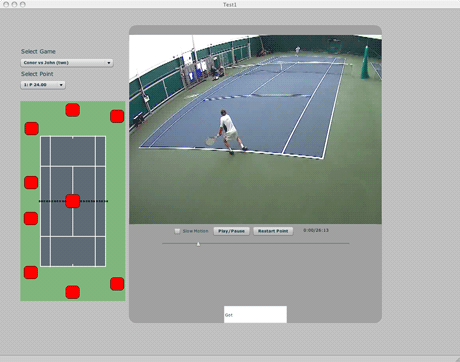by Noel E. O'Connor, Philip Kelly, Ciarán Ó'Conaire, Damien Connaghan, Alan F. Smeaton, Brian Caulfield, Dermot Diamond and Niall Moynahan
The evolution of the World-Wide Web to the Sensor Web is providing an unprecedented opportunity to develop novel applications in a variety of domains. In this article we describe our work on multi-modal sensing for sport.
Sensor technology is rapidly changing the professional sporting landscape. Modern motor racing has been virtually transformed by the introduction of sophisticated drive-by-wire sensor technology, for example. Similarly, the ability to accurately monitor the performance of an athlete during training is having a major influence on a wide range of track and field events. In this project we introduce state-of-the art sensing technology onto the tennis court with a view to facilitating coaches as they train the next generation of tennis superstars. These sensors make it possible for coaches to obtain a second-by-second record of player performance that goes far beyond what can be captured by more traditional techniques; simply eyeballing the player as they move, serve, volley and return, does not reveal what might be going on under the surface in terms of the player's ever-changing performance profile, his/her breathing patterns, and the stresses and strains that they are feeling in their joints and muscles.

The project is a collaboration between CLARITY (The Centre for Sensor Web technologies) and Tennis Ireland, the national governing body for tennis, based in Dublin City University. We have instrumented an all-weather tennis court with nine Internet-enabled cameras with built-in microphones. This is linked to a localization system that identifies the player's position to within 15cm by triangulating the radio signal emitted by small tags carried by the players in their pockets. The coach uses a simple wireless device to signal an important event during play via a simple button press. After training, these button presses are synchronized to the video streams. Content analysis mechanisms are then used to define the precise start and end of tennis play around these locations. We do this by tracking the ball in each camera, measuring player speed using the location information and detecting the sound of a ball hitting a racquet. These detected events are used in a variety of Web-based coaching tools. These include (a) being able to view individual tennis strokes from multiple view points, (b) support for online coaching feedback (eg This shot was the wrong choice given the location of your opponent when you played it), and (c) an easy way for coaches and athletes to produce personalized annotated video summaries for players to download and review for motivational purposes.
Integrating Smart Materials and Body Sensor Networks
By its very nature, this project requires convergence between multiple disciplines in order to be successful. It requires input from engineers for signal processing and content analysis aspects and from computer scientists for addressing indexing, archival, personalization and user interface issues. Sports scientists play the crucial role of mediating between the technologists and the end-user coaches and athletes. Their input is invaluable in helping translate a complicated set of domain-specific and expert-driven requirements into a set of concrete technical functionalities. This helps ensure the practical relevance and usefulness of any technology developed. They also help ensure that coaches and athletes understand the potential benefits of the technology, thereby stimulating take-up by the key stakeholders.
However, the potential for convergence extends even beyond this initial constituency. More generally, the sensed environment can be considered as an experimental platform for trialling wearable sensing. The wireless inertial sensing platforms being developed by CLARITY engineers will be integrated into the system with a view to providing biomechanical feedback to athletes. The smart materials being developed by chemists in the CLARITY work programme will be integrated into body sensor networks and will allow a variety of important physiological and biometric indicators to be detected.
To date, most data gathering and experimentation with this technology happens within a laboratory. The Tennis Ireland installation provides infrastructure for data gathering, analysis and feedback that will allow this technology to be tested in the field, during real exercise. For example, the work on conducting polymers will result in textiles for measuring stretching, bending and pressure movements. This 'smart foam' will be built into the wearable platform of one of our industry partners and trialled with tennis players to monitor specific muscle movement and strain. Data collection and feedback can be piggy-backed on the existing system, with the added benefit of a synchronized multi-view video to augment expert analysis of data from the wearable sensors.
A longer-term example is the 'sweat patch' being developed to measure the pH of sweat. A change in sweat pH may signal an increased reliance on anaerobic metabolism, but there is a lack of reliable methods for assessing pH during exercise. CLARITY is working on a new fluid-handling platform based on polyamide lycra. The device consists of a super-absorbent material that provides a passive pumping mechanism to control fluid flow. The optical detection of pH-induced colour changes in the dye is achieved via a paired emitter-detector LED system. The Tennis Ireland installation provides an ideal framework for testing this innovative technology in a real application scenario with real users.
Please contact:
Noel E O'Connor
CLARITY Centre for Sensor Web Technologies, Dublin City University, Ireland
Tel: +353 1 700 5078
E-mail: oconnorn![]() eeng.dcu.ie
eeng.dcu.ie










